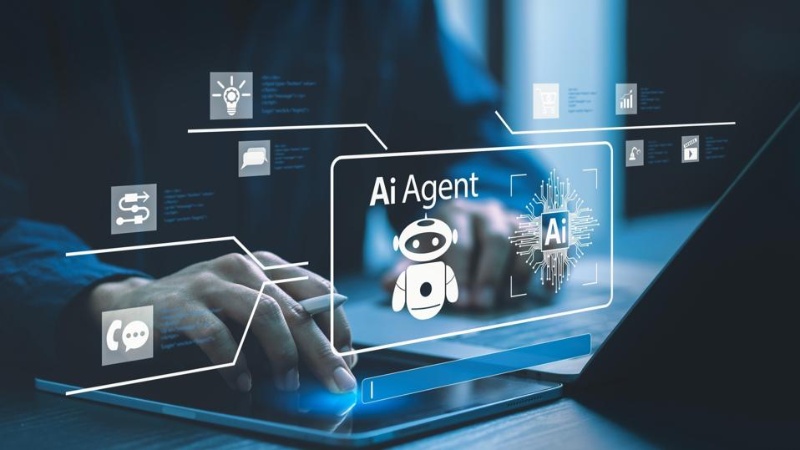Introduction: The Static Knowledge Base Problem
You need a specific technical specification from your company’s vast knowledge base. You type a keyword into the search bar and are met with a list of hundreds of documents. You click the top result—a 50-page PDF from 2021. You spend the next ten minutes scrolling, using Ctrl+F, and hoping the information is both in there and still accurate. This is the daily reality of the static knowledge base: a digital library that requires more effort to navigate than it saves.
For years, corporate knowledge has been locked away in these passive repositories—SharePoint sites, Confluence pages, and network drives filled with documents, slides, and spreadsheets. They don’t understand your question, they can’t connect related ideas, and they certainly can’t take action. They are archives, not assistants.
This is now changing. AI Agents are emerging as the intelligent key, transforming these static folders into dynamic, conversational, and proactive partners. Powered by sophisticated Large Language Models (LLMs), these agents don’t just store information; they understand it, reason with it, and use it to solve problems. However, this monumental upgrade in capability requires a equally powerful and reliable engine under the hood—significant computational power that must be delivered efficiently and cost-effectively.
1. What is an AI Agent? Beyond Simple Chatbots
It’s easy to confuse an AI Agent with the simple chatbots of the past. But the difference is like that between a GPS that gives turn-by-turn directions and a veteran tour guide who knows all the hidden shortcuts.
A simple chatbot operates on a pre-defined set of rules and keyword matching. If your question contains “reset password,” it might pull a standard article. If your query deviates even slightly—”I’m locked out of my account after the holiday”—it fails.
An AI Agent, in the context of knowledge management, is an autonomous system that leverages an LLM to perceive its environment (your knowledge base), make decisions, and execute actions to achieve a goal (answering your question). Its core capabilities include:
- Reasoning: The agent analyzes the true intent behind a complex query. For “I’m locked out of my account after the holiday,” it understands that the user likely forgot their password following a break and needs a secure reset process, not just a generic article.
- Tool Use: This is the superpower. The agent isn’t limited to one database. It can use tools—like retrieving a specific document from your SharePoint, querying a Salesforce API for a client’s order history, or checking the internal IT status page—all within a single conversation.
- Action: Beyond providing an answer, the agent can initiate a workflow. It can not only tell you the password reset procedure but also automatically generate a ticket in Jira for the IT team, pre-filled with the user’s context.
An AI Agent is, therefore, an active employee that uses the entire corporate knowledge base as its toolkit.
2. The Synergy: How AI Agents Supercharge Your Knowledge Base
The integration of an AI Agent transforms the relationship between your team and its collective knowledge. The synergy turns a burden into a benefit.
From Passive to Proactive:
Your knowledge base is no longer a place you go to; it becomes a system that works for you. Instead of searching, you are conversing. The agent actively participates in problem-solving, asking clarifying questions and pulling together disparate threads of information you might have missed.
Natural Language Querying:
The barrier of “knowing the right keyword” vanishes. An engineer can ask, “What was the conclusion from the Q3 summit regarding the Project Alpha latency issues, and show me the related error logs from last week?” The agent understands the complex, multi-part request and executes it.
Synthesized Answers:
The agent doesn’t just dump ten links in your lap. It reads and comprehends all of them—the summit minutes, the engineering post-mortem, the log files—and synthesizes a single, comprehensive, and summarized answer in plain English, citing its sources.
Always-Up-to-Date:
When connected to live data sources and communication platforms like Slack or Teams, the agent can provide real-time knowledge. It can tell a salesperson on a call, “Yes, Client X is eligible for the premium support tier, and their current contract expires in 45 days,” by pulling live from CRM and contract databases.
This is the intelligent upgrade: a knowledge base that is conversational, comprehensive, and context-aware.
3. The Engine Room: The Computational Demand of Intelligent Agents
This intelligence, however, doesn’t come for free. The magic of the AI Agent is powered by a very real, very demanding engine: Large Language Models. Running these sophisticated models requires immense, reliable, and high-performance computational power.
Consider what happens when a user asks your AI Agent a question:
- The query is sent to the underlying LLM.
- The model, with its billions of parameters, must process the request in real-time. This is known as inference.
- To be fast enough for a conversational experience, this inference requires low latency—answers must come back in seconds, not minutes.
This is where Graphics Processing Units (GPUs) become non-negotiable. The entire LLM must be loaded into the fast GPU memory to be accessed instantly. If the model has to swap data in and out of slower system memory, latency skyrockets, and the user experience is destroyed. For a large enterprise deploying multiple agents serving thousands of employees, this demand must be scaled across a cluster of GPUs, creating a complex orchestration challenge. The intelligence of your agent is directly limited by the power and efficiency of its GPU infrastructure.
4. Powering the Intelligence: Why Your AI Agent Needs WhaleFlux
Building and maintaining this high-performance GPU infrastructure in-house is a massive undertaking. This is where WhaleFlux becomes the critical, enabling partner for your AI ambitions. WhaleFlux is an intelligent GPU resource management tool designed specifically for AI enterprises, ensuring your AI Agents are not just intelligent, but also fast, stable, and cost-effective.
The WhaleFlux Advantage for AI Agents:
Guaranteed Speed & Stability:
WhaleFlux ensures the LLM behind your agent is always responsive. By optimally managing GPU resources, it eliminates the slow or failed queries that break user trust. When an employee asks a critical question, they get an answer instantly, not after a frustrating wait that forces them to give up.
Optimized GPU Clusters:
Manually managing a cluster of GPUs is a full-time job for a team of experts. WhaleFlux automates this. It intelligently schedules and allocates workloads, ensuring your AI Agent has the dedicated GPU power it needs, the moment a query comes in. This means consistent performance, even during peak usage.
Cost-Effective Scaling:
The power of AI Agents means they will be used across your organization. WhaleFlux allows you to run multiple, powerful agents serving different departments simultaneously without exorbitant cloud costs. By maximizing the utilization of every GPU in your cluster, WhaleFlux ensures you are getting the maximum value from your compute investment, significantly lowering your total cost of ownership.
With WhaleFlux, your AI team can focus on building and refining the agent’s capabilities, not on managing the complex infrastructure that powers it.
5. The Hardware Foundation: Built on NVIDIA’s Best
Superior software requires superior hardware. WhaleFlux provides the raw, uncompromising power for your most ambitious AI Agent projects through direct access to a fleet of top-tier NVIDIA GPUs.
We provide the specific tools for the job:
For Largest-Scale Agent Deployments:
The NVIDIA H100 and H200 Tensor Core GPUs are designed for the most demanding AI workloads. Their massive, high-bandwidth memory is ideal for serving the largest and most complex LLMs that power enterprise-wide agent systems, ensuring lightning-fast responses for thousands of concurrent users.
For High-Performance Enterprise Agents:
The NVIDIA A100 remains a powerful and reliable workhorse for enterprise AI. It offers exceptional performance for training and deploying robust agents that handle complex internal knowledge workflows.
For Development & Powerful Inference:
For research, development, and cost-effective deployment of smaller-scale agents, we offer the NVIDIA RTX 4090 and other powerful NVIDIA GPUs, providing an excellent balance of performance and value.
To provide stability and cost predictability, our GPUs are available for purchase or for rent with a minimum commitment of one month, moving beyond the unpredictable and often expensive volatility of hourly cloud billing. This model is perfect for the long-term, always-on nature of a corporate knowledge AI Agent.
Conclusion: Unlock the True Potential of Your Corporate Knowledge
The transformation is clear. AI Agents are the key to unlocking the immense, untapped potential trapped within your corporate knowledge base. They turn static information into an intelligent, active, and strategic asset that drives efficiency, accelerates decision-making, and empowers every employee.
Making this leap successfully requires a foundation of powerful, reliable, and manageable computational power. It requires an infrastructure partner that understands the demands of enterprise AI.
Ready to build the intelligent knowledge base of the future? Leverage the power of WhaleFlux to deploy powerful, reliable, and cost-effective AI Agents that deliver real-time knowledge and drive your business forward. Contact us today to find the right NVIDIA GPU solution for your needs.

